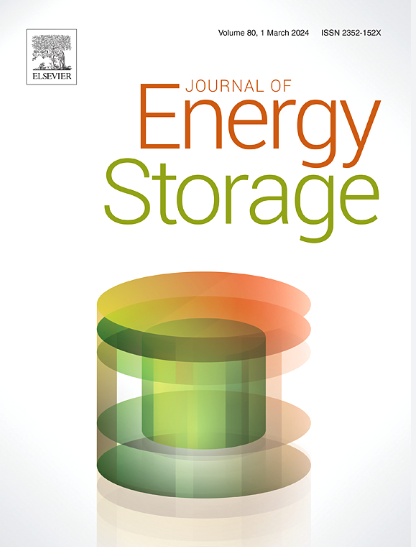Fabrication of flexible conducting UiO-66/phytagel/NaCl/glycerol composite sheets and their performance as electrolytes for supercapacitor applications
IF 8.9
2区 工程技术
Q1 ENERGY & FUELS
引用次数: 0
Abstract
The energy density of solid polymer electrolytes (SPEs) is limited by low ionic conductivity caused by interfacial resistance at the electrode-electrolyte interface. To address this issue, composite solid polymer electrolytes (CSPEs) were developed by incorporating UiO-66 (metal-organic framework), phytagel, NaCl and glycerol. FTIR analysis confirms the absence of any new chemical bonding, indicating the formation of ideal CSPE. PXRD analysis showed reduced crystallinity upon blending UiO-66/phytagel and glycerol. Morphological analysis via FESEM shows the homogeneity of the composite material. Electrochemical Impedance Spectroscopy (EIS) revealed a stepwise reduction in bulk resistance with the successive addition of UiO-66, NaCl and glycerol, leading to the final CSPE, which exhibited the highest ionic conductivity of 1.00 × 10−03 S cm−1 with synergistic dielectric properties. The electrochemical stability window of the CSPE was reported from −0.8 V to +2.3 V. Cyclic voltammetry (CV) demonstrated a specific capacitance of 144 F g−1 at 1 mV s−1 and 12 F g−1 at 100 mV s−1. Coulombic efficiency remained ∼95 % and ∼ 99 % at 0.1 and 0.05 A g−1 up to 1000 cycles during galvanostatic charge-discharge (GCD) analysis, showing the long-term capability of charge-discharge in the device. These findings highlight the material's potential for next-generation energy storage applications.

柔性导电UiO-66/phytagel/NaCl/甘油复合片材的制备及其作为超级电容器电解质的性能
固体聚合物电解质(spe)的能量密度受到电极-电解质界面电阻导致的低离子电导率的限制。为了解决这一问题,将UiO-66(金属有机骨架)、植酸盐、NaCl和甘油加入到复合固体聚合物电解质(cspe)中。FTIR分析证实没有任何新的化学键,表明形成了理想的CSPE。PXRD分析表明,UiO-66/phytagel与甘油共混后结晶度降低。FESEM形貌分析表明复合材料具有均匀性。电化学阻抗谱(EIS)显示,连续添加uuo -66、NaCl和甘油后,CSPE的体积电阻逐渐降低,最终的CSPE具有最高的离子电导率,为1.00 × 10−03 S cm−1,具有协同介电性能。CSPE的电化学稳定窗口为−0.8 V ~ +2.3 V。循环伏安法(CV)表明,在1 mV s−1时的比电容为144 F g−1,在100 mV s−1时的比电容为12 F g−1。在恒流充放电(GCD)分析中,库仑效率在0.1和0.05 A g−1下保持~ 95%和~ 99%,达到1000次循环,显示了器件的长期充放电能力。这些发现突出了这种材料在下一代储能应用方面的潜力。
本文章由计算机程序翻译,如有差异,请以英文原文为准。
求助全文
约1分钟内获得全文
求助全文
来源期刊

Journal of energy storage
Energy-Renewable Energy, Sustainability and the Environment
CiteScore
11.80
自引率
24.50%
发文量
2262
审稿时长
69 days
期刊介绍:
Journal of energy storage focusses on all aspects of energy storage, in particular systems integration, electric grid integration, modelling and analysis, novel energy storage technologies, sizing and management strategies, business models for operation of storage systems and energy storage developments worldwide.
 求助内容:
求助内容: 应助结果提醒方式:
应助结果提醒方式:


